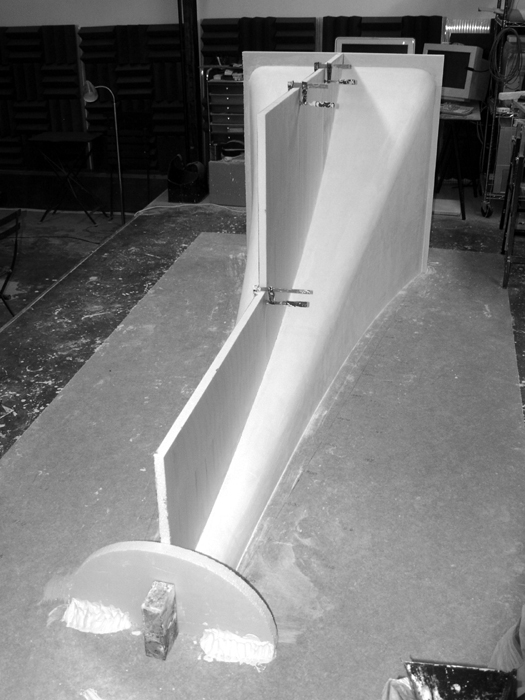fiogf49gjkf0d
To answer Romy's questions :
Drivers :
Vitavox AK151
Resonant frequency :
I did not try to measure it. Can anyone confirm the following : I assume this parameter is most easily determined by playing a series of tones at constant signal strength (volume setting) while measuring the SPL; the frequency of a tone that gives the highest SPL is the resonant frequency of the assembly. Is this correct?
Filters :
Initially I ran the horn full range, without the other horns. I was immediately sort of horrified at how high (in frequency) it would play. I then stuck a 5mH coil in front of it, so as to low pass somewhere around 200Hz (really could have used a 3.5mH coil, but didn't have one on hand). Next I made a band pass filter to give a theoretical operating range between 90 and 185 (normally I'd let it go higher, to around 250Hz but again, I didn't have exactly the right stuff sitting on the shelf... Used a 150µF cap followed by a 10mH coil; driver measures around 6 Ohms). In case its not clear, the filter is first order. So now with things reined in a bit, I sat down to listen, both with and without the other horns.
Sound :
First, I may be totally off here, as I was extrapolating potential from a situation where the horn was about 15 ft out in front of the other horns, so any evaluation in the context of the rest of the system is to be taken lightly. Given that disclaimer, I will say that I was satisfied in a very basic way. This may seem obvious; I sought first to confirm the presence of real mid-bass as compared to what happens when filling in for the absence of this horn as I had been doing, by running the other channels beyond their ideal range (running the 115Hz horns down lower than they should go, while running the lower bass enclosures up higher than they should go... For this session, I did go to the trouble of changing the filters on those channels, moving their operating ranges out of mid-bass territory). Well so do I now have real mid-bass? At this point I can only say that this bass differs in that it is not as constrained sounding, but more weightless and relaxed... Somewhat a contrast to the way the horn looks. Next I would say that despite being way out in front, in the context of the rest of the system, the sound of the additional channel did not call attention to itself; my neighbor however, listening from his apartment, did ask if I hadn't changed something... To me, the system did not seem any louder. Removing the horn from the system (to make space for creation of the second one) turned out to be difficult, and not just because of its mass; given the horn's position, I know how silly this will seem, but momentarily disconnecting the channel had already confirmed that its contribution would be missed; the result was that it stayed there for about a week. I will post more observations once I get the pair of them up and running.
Weight :
One horn without driver, rear chamber or supporting chassis and wheels weighs around 900 lbs. Heavy yes, but not excessive; with music playing at live listening levels, one's hand is enough to detect whether or not the horn is working. The assembly comes apart in quarters split along the horn's firing axis (see clamped flanges in photos above). A single multi-layer lamination (about 1" thick) over the forming tool or buck yields one pair of mirrored quarters, or half a horn. I will post photos of the construction process some time in the future.
Hang on a minute... I see what may be a sign of progress in the ability to upload images to the cat's server via a Mac navigator... I'll now attempt to post an image of the forming tool (do not hold your breath) :

Well I'll be damned ! Meow !
Above is the forming buck, soon to receive a coat of shelack, followed by several coats of wax.
jd*
Whoa... An "Edit" button! Nice work Romy !
Ok, its a bit screwy (done several edits trying to get the font and colors right and the thing seems to have a mind of its own) but this is real progress.
How to short-circuit evolution: Enshrine mediocrity.